buy prednisone online prednisone online no prescription
9 percent. This is a controversial topic involving esoteric debates about calorie intake and such, in Sri Lanka as well as in other countries such as India. So I thought I’ll come at it from a different angle, that of Engel’s Law which states that “as income rises, the proportion of income spent on food falls, even if actual expenditure on food rises.”
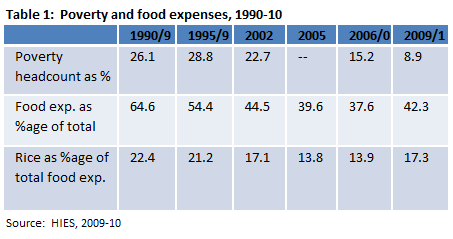 After declining from a high of 64.6 percent in 1990-91 to 37.6 in 2006-07, the proportion spent on food increased in the three years prior to the latest household survey by a significant 4.7 percent. Not only that, but a similar 4.6 percent increase has occurred in expenditure on rice as a percent of total food expenditures. Not only are we going counter to Engel’s Law, but we are also going against its corollary which says there should be a shift from carbohydrates to protein within the food budget. Taken alone, these numbers could be interpreted as a rise in poverty.
However, increases in protein expenditures on fish (our main source of protein) from 8.6 percent in 2006-07 to 8.8 percent in 2009-10 suggest otherwise. There also are significant increases in certain non-food items.
After declining from a high of 64.6 percent in 1990-91 to 37.6 in 2006-07, the proportion spent on food increased in the three years prior to the latest household survey by a significant 4.7 percent. Not only that, but a similar 4.6 percent increase has occurred in expenditure on rice as a percent of total food expenditures. Not only are we going counter to Engel’s Law, but we are also going against its corollary which says there should be a shift from carbohydrates to protein within the food budget. Taken alone, these numbers could be interpreted as a rise in poverty.
However, increases in protein expenditures on fish (our main source of protein) from 8.6 percent in 2006-07 to 8.8 percent in 2009-10 suggest otherwise. There also are significant increases in certain non-food items.
 Except for the key anomaly of food, Sri Lankans seem to be getting richer. The food spike will have to be investigated further, but the anomalous period seems to overlap with a spike in global food prices. We import little to no rice, but it is possible that the world trends play out here too.
Except for the key anomaly of food, Sri Lankans seem to be getting richer. The food spike will have to be investigated further, but the anomalous period seems to overlap with a spike in global food prices. We import little to no rice, but it is possible that the world trends play out here too.
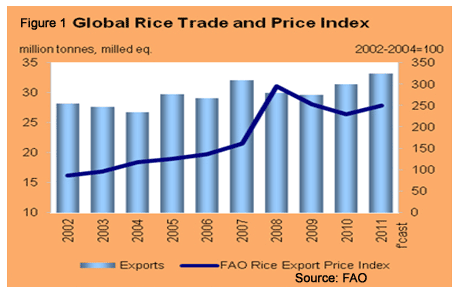 Not getting an unambiguous answer from HIES and Engel’s Law, I decided to look at assets in households, a common proxy for poverty: more assets, less poor.
Not getting an unambiguous answer from HIES and Engel’s Law, I decided to look at assets in households, a common proxy for poverty: more assets, less poor.
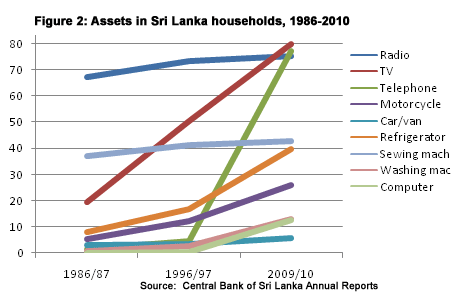 Assets are increasing in households except for radios, possibly being replaced by fast-growing TVs. The refrigerator is almost catching up with old favorite, the sewing machine. Even computer households are in double digits.
Are any Provinces lagging?
Assets are increasing in households except for radios, possibly being replaced by fast-growing TVs. The refrigerator is almost catching up with old favorite, the sewing machine. Even computer households are in double digits.
Are any Provinces lagging?
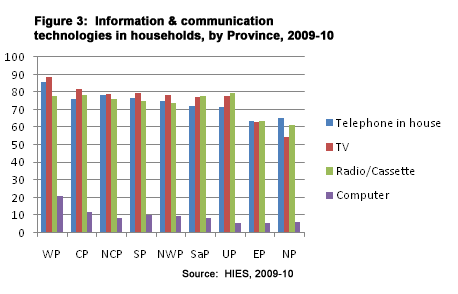 As expected, only 14 percent of Western Province households are without some kind of telephone and only 12 percent are without a TV. The Eastern and Northern Provinces are the laggards, with around 35 percent households without telephones. The other provinces are clustered in the middle, with over 70 percent households having a telephone, TV and radio. Noteworthy was the high performance of the North Central Province, a war-affected region and a former laggard.
Other assets that are likely to tell of poverty are electrical or gas-powered equipment, especially now that more than 80 percent of households have access to electricity.
As expected, only 14 percent of Western Province households are without some kind of telephone and only 12 percent are without a TV. The Eastern and Northern Provinces are the laggards, with around 35 percent households without telephones. The other provinces are clustered in the middle, with over 70 percent households having a telephone, TV and radio. Noteworthy was the high performance of the North Central Province, a war-affected region and a former laggard.
Other assets that are likely to tell of poverty are electrical or gas-powered equipment, especially now that more than 80 percent of households have access to electricity.
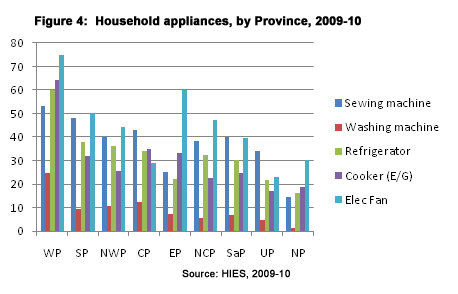 Here again, the Western Province is in a class of its own, with 60 percent of households owning refrigerators and 25 percent having washing machines. Electrical or gas cookers are in 63 percent of Western Province households, and in over 30 percent of Southern, Central and Eastern Province households. Uva and Northern Provinces bring up the rear, with the North showing low ownership even of the ubiquitous sewing machine.
Here again, the Western Province is in a class of its own, with 60 percent of households owning refrigerators and 25 percent having washing machines. Electrical or gas cookers are in 63 percent of Western Province households, and in over 30 percent of Southern, Central and Eastern Province households. Uva and Northern Provinces bring up the rear, with the North showing low ownership even of the ubiquitous sewing machine. buy clomiphene online clomiphene online no prescription
Anomalous in this case is the Eastern Province, helped perhaps by a great affection for electrical fans and cookers and enabled perhaps by short-term expatriate work. Household assets as a proxy for income levels, suggests that the Northern and Eastern provinces are the least well off, unsurprisingly.
buy xifaxan online xifaxan online no prescription
Among the usual suspects at the back of the line, the North Central Province appears to have pulled ahead. Uva is still a laggard, with Sabaragamuva on the cusp. For province-wide efforts, the North and the East must be given priority; the LTTE’s damage must be undone. Of course, there are hard pockets of poverty in each of the other provinces. Even the city of Colombo has homes that lack a TV or a phone.
buy zovirax online buy zovirax online no prescription
Focused efforts are required for these hard cases. Disaster vulnerability Disasters, along with sickness, pull down families as they fight their way out of poverty. Relief in the aftermath of disasters is important, but even more important is action to reduce the risks to lives and livelihoods. In my judgment, the major hazards that pose the greatest threats to lives and livelihoods of Sri Lankans are: • Floods, caused or exacerbated by dam breaks • Cyclones and tidal surges • Tsunami • Drought Sri Lanka has perhaps one of the world’s highest ratios of inland water to land area, with 12,000 small reservoirs and 350 medium and large reservoirs. The reservoirs could serve as buffers for spikes in rainfall, likely to be caused by climate change. They could also exacerbate floods if not properly maintained, as was the case with the twin floods of January 2011. Those outside government should add their voices and resources to the government’s efforts to rehabilitate the most vulnerable dams, just 32 out of the thousands that need repair. If we can shift government away from the current dysfunctional reliance on rehabilitation to a consistent culture of maintenance, we will have done much to save lives and livelihoods throughout the country. Cyclones, tidal surges and tsunamis are a fact of life on the East Coast and parts of the Southern and Northern coastlines. Risks can be reduced by ensuring adherence to appropriate building codes, ensuring that early warning is provided over the ubiquitous CDMA and GSM phones, and that communities are prepared to safeguard their lives and livelihoods through contingency planning. The first and second actions are within the purview of government, while civil society is best placed to act on the third action. In the case of drought as well as the other major hazards, government, the private sector and civil society must engage in a comprehensive effort to increase participation rates in insurance and to make available the right kinds of insurance packages. Rohan Samarajiva heads LirneAsia, a regional think tank. He was also a former telecoms regulator in Sri Lanka. To read previous columns go to LBOs main navigation panel and click on the 'Choices' category.
